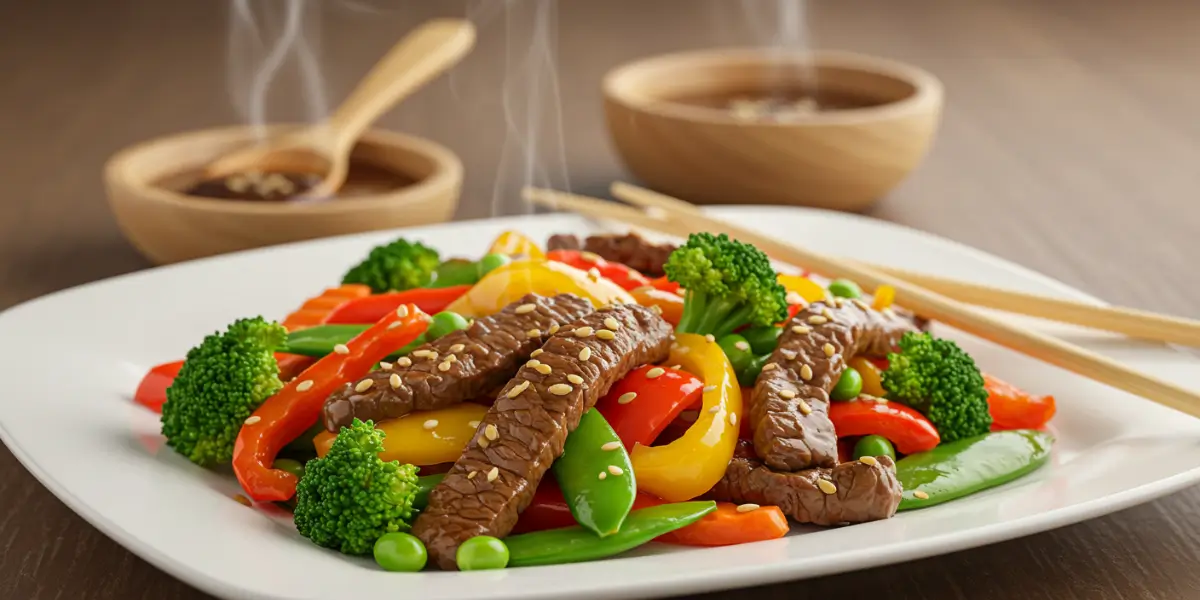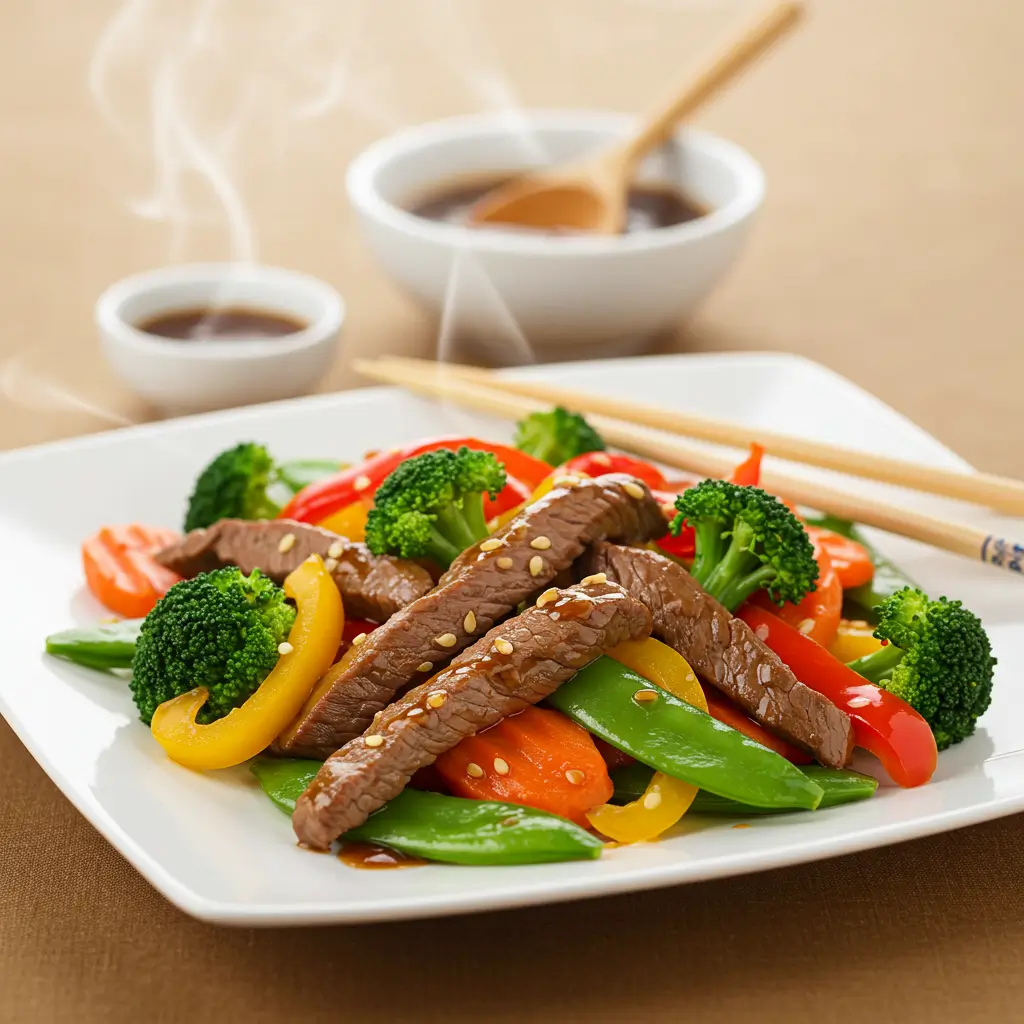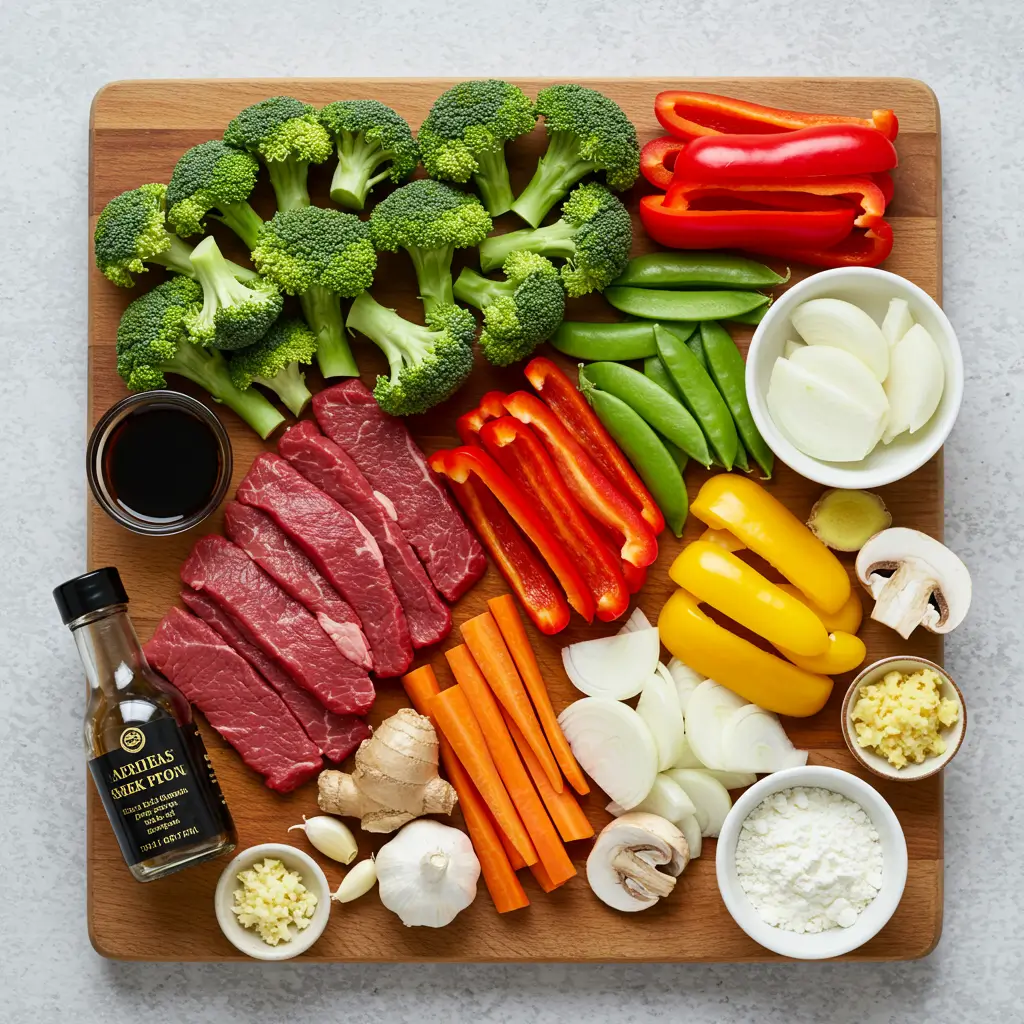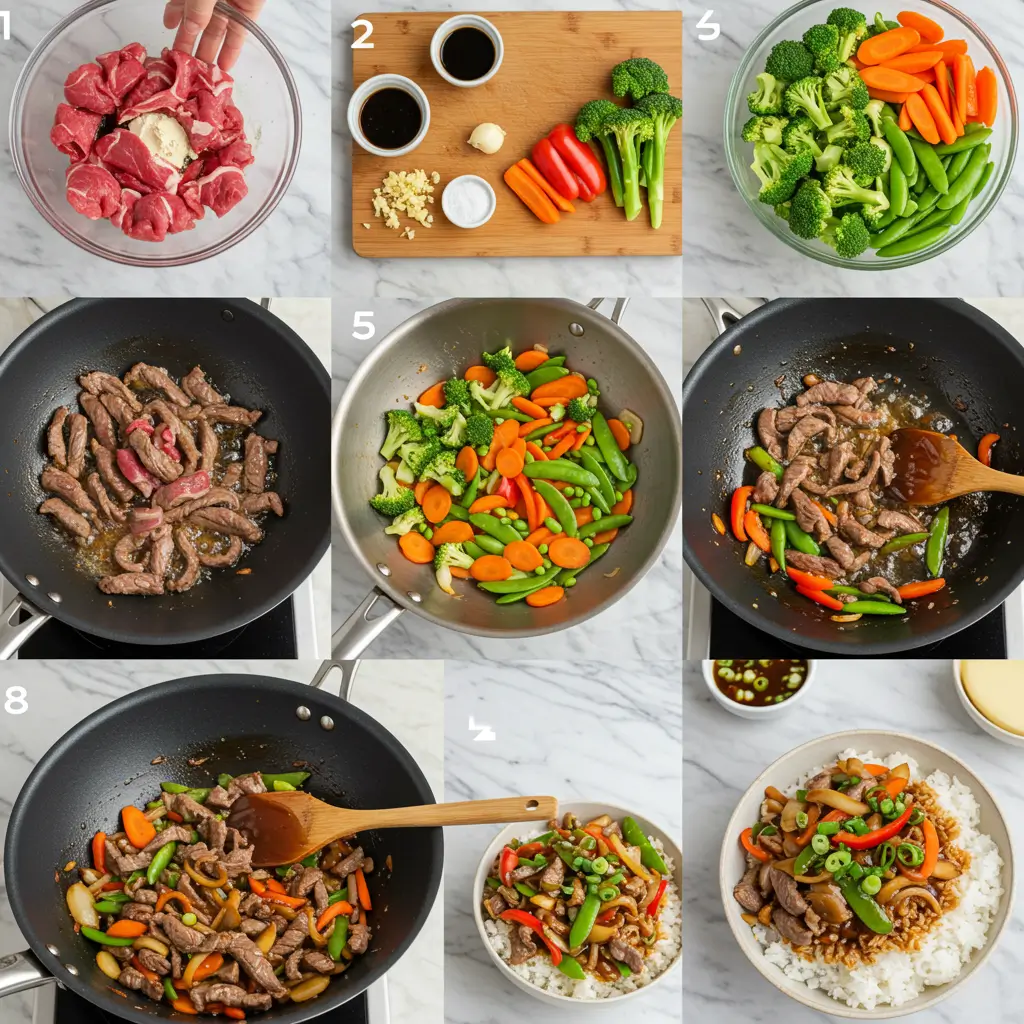The Ultimate Beef Stir Fry with Vegetables

Picture this: It’s 6 PM on a Tuesday. You’re exhausted after a long day, your stomach is rumbling insistently, and the idea of embarking on a complicated cooking project feels like climbing Mount Everest in fuzzy slippers. The siren song of takeout menus scattered on the counter is getting louder, whispering sweet nothings about convenience and minimal cleanup.
But wait – pause that delivery app order! What if you could whip up something incredibly flavorful, visually stunning with vibrant colors, packed with wholesome goodness, and have it steaming hot on your table faster than that delivery driver could ever navigate traffic? Imagine succulent, melt-in-your-mouth tender strips of beef mingling with perfectly crisp-tender vegetables – broccoli that still snaps, peppers that retain their bright sweetness – all coated in a luscious, glossy, savory sauce that you crafted right in your own kitchen.
This isn’t a culinary fantasy; it’s the completely achievable reality of mastering the perfect Beef Stir Fry with Vegetables. Forget greasy, overly salty, or disappointingly soggy takeout disappointments. We’re about to unlock the simple secrets and techniques that will empower you to create a stir fry at home that’s not just as good as restaurant versions, but demonstrably better. Get ready to transform your weeknight dinner routine!
Why You’ll Fall in Love with Homemade Beef Stir Fry with Vegetables
Before we dive into the nuts and bolts (or rather, the beef and broccoli!), let’s appreciate why dedicating a little effort to making your own Beef Stir Fry with Vegetables is so incredibly worth it. It’s more than just a meal; it’s a smart solution for modern life.
- Speed Demon Dinners: Faster Than Takeout, Fresher Than Ever
Seriously, this is one of the fastest meals you can make from scratch. The key is mise en place – a fancy French term for “having everything in its place.” Once your beef is sliced, your veggies are chopped, and your sauce is mixed (which can often be done ahead of time!), the actual cooking process is a whirlwind of high-heat action that takes maybe 10-15 minutes tops. You’ll likely have dinner on the table before you could even finish debating takeout options and placing an order. Plus, the freshness is unparalleled. - Total Control: Customizing Your Healthy Flavor Fiesta
This is where homemade truly shines. You are the master of your stir fry universe! Don’t like mushrooms? Leave them out! Obsessed with broccoli? Load it up! Need to use up those lingering bell peppers? Toss them in! You control the quantity and type of vegetables, ensuring a nutrient-packed meal tailored precisely to your tastes and dietary needs. You also control the sodium, sugar, and oil content, making your Beef Stir Fry with Vegetables significantly healthier than most restaurant counterparts. Want it spicier? Add more chili flakes. Gluten-free? Easy swap with Tamari. Low-carb? Serve over cauliflower rice. The power is yours!

- Taste the Difference: Achieving Authentic Stir Fry Flavor at Home
There’s a certain magic to a well-executed stir fry – that elusive wok hei or “breath of the wok,” a subtle smokiness achieved through high heat searing. While challenging to perfectly replicate without a high-BTU restaurant burner, you can get remarkably close at home! By using fresh aromatics like garlic and ginger, balancing your sauce perfectly, and cooking ingredients quickly at high temperatures, you create layers of flavor that are bright, distinct, and deeply satisfying. It tastes real and vibrant in a way mass-produced takeout often doesn’t. Making your own Beef stir fry with vegetables puts authentic flavor within reach.
Ingredient Spotlight: Building Your Perfect Stir Fry Foundation
A masterpiece requires quality materials. Let’s break down the essential components for an unforgettable Beef Stir Fry with Vegetables.
- Choosing Your Champion: The Best Beef Cuts and How to Slice Them Thin
The beef is the star, so choosing the right cut and preparing it properly is crucial for tenderness.- Top Choices: Flank steak is a classic for its rich flavor and clear grain (making slicing easier). Sirloin steak (especially top sirloin) is naturally more tender and readily available. Skirt steak offers intense beefiness but needs careful trimming and slicing. Flat iron is another excellent tender option.
- The Golden Rule: Slice Thinly Against the Grain. This is non-negotiable for tender results. Locate the direction the muscle fibers run (the grain), then slice perpendicular to those fibers, aiming for strips about 1/4-inch thick or even thinner. Partially freezing the beef for 20-30 minutes firms it up, making ultra-thin slicing much easier. This technique shortens the long muscle fibers, making them easy to chew rather than tough.
- The Veggie Rainbow: Selecting and Prepping Vegetables for Optimal Crunch
Think color, texture, and flavor variety! Aim for 3-5 different types of vegetables.- Prep is Key: Wash and chop all your vegetables into uniform, bite-sized pieces before you even think about turning on the stove. This ensures even cooking.
- Hardy Veggies (Need more cooking time): Broccoli florets, carrots (slice thinly on a diagonal or julienne), cauliflower florets, celery (slice diagonally). Consider blanching these for a minute if you prefer them more tender.
- Medium-Cook Veggies: Bell peppers (any color, sliced or diced), onions (wedges or thick slices), mushrooms (sliced or quartered), snap peas, snow peas (strings removed).
- Quick-Cook Veggies (Add near the end): Bok choy (separate leaves and stems; add stems earlier, leaves last), bean sprouts, zucchini (sliced), asparagus (cut into 1-inch pieces), canned water chestnuts (drained).
- Pro Tip: Group veggies by cook time so you can add them to the wok sequentially.
- Pantry Powerhouses: Essential Aromatics and Sauces for That Signature Taste
These are the flavor workhorses of your stir fry.- Aromatics (The Fragrant Base): Fresh garlic (minced or thinly sliced) and fresh ginger (grated or minced) are fundamental. Don’t skimp here – they add incredible depth. Green onions (scallions), sliced thin, with whites used in cooking and greens for garnish, add a fresh, pungent kick.
- Sauce Staples:
- Liquid Base: Low-sodium soy sauce (or Tamari/Coconut Aminos for GF), beef or chicken broth (adds depth).
- Umami & Depth: Oyster sauce (a classic, adds savory sweetness), Hoisin sauce (sweeter, thicker).
- Aroma & Finish: Toasted sesame oil (use sparingly, add off-heat or in the sauce/marinade as it has a low smoke point).
- Balance: Rice vinegar (a splash brightens flavors), sugar or honey (a touch balances the saltiness).
- Heat (Optional): Red pepper flakes, Sriracha, or chili garlic sauce.
- Thickener: Cornstarch (or arrowroot powder) is essential for both marinating the beef and thickening the final sauce.
- Cooking Oil: Choose a neutral oil with a high smoke point, like avocado, peanut, canola, grapeseed, or vegetable oil.

Mastering the Wok (or Skillet!): Key Techniques for Stir Fry Success
Okay, ingredients are prepped like soldiers ready for battle. Now, let’s talk technique – this is where the magic happens for your Beef Stir Fry with Vegetables.
- The Velveting Secret: Achieving Incredibly Tender Beef Every Time
Ever wonder how restaurant beef stays so tender? Often, it’s “velveted.” This simple technique involves marinating the thinly sliced beef in a mixture typically containing soy sauce, cornstarch, and often a liquid like water, rice wine (Shaoxing), or egg white. The cornstarch creates a microscopic coating that protects the beef from the intense heat, sealing in moisture and resulting in a silky, tender texture. Even a basic marinade with soy sauce and cornstarch for 15-30 minutes makes a huge difference. Don’t skip this step if you want truly tender beef! - Crank Up the Heat: Why High Temperature is Non-Negotiable
Stir-frying is defined by high heat and speed. You need your wok or skillet screaming hot before the oil goes in, and the oil should shimmer or let off faint wisps of smoke almost immediately. This intense heat allows the ingredients to sear quickly, developing flavor (that coveted wok hei) and cooking rapidly without becoming soggy. If the pan isn’t hot enough, the ingredients will steam in their own juices – the enemy of a good stir fry. Use your stove’s most powerful burner and let the pan preheat thoroughly (usually 2-5 minutes). - Give Them Space: The Art of Batch Cooking to Avoid Steaming
This is arguably the most common mistake made by home cooks. Overcrowding the pan instantly drops the temperature, leading to that dreaded steaming effect instead of searing. Your beef turns grey and chewy, your vegetables get limp and waterlogged. The solution? Cook in batches!- Sear the Beef: Cook the marinated beef in a single layer (do it in two batches if necessary). Get a good sear, then remove it from the pan and set it aside while it’s still slightly undercooked (it will finish cooking later).
- Cook the Veggies: Add a bit more oil if needed, then stir-fry the vegetables, again in batches if necessary. Start with the hardest veggies that need more time, then add the medium ones, and finally the quickest-cooking ones. Keep everything moving constantly.
The Grand Finale: Crafting the Perfect Sauce and Serving Your Beef Stir Fry with Vegetables
You’ve seared the beef, stir-fried the veggies – now it’s time to bring it all together with that glorious sauce.

- Sauce Alchemy: Balancing Sweet, Savory, and Umami Flavors
A great stir fry sauce hits multiple taste receptors. The key is balance. Mix your sauce ingredients (broth, soy sauce, oyster/hoisin sauce, vinegar, sugar, sesame oil – except the slurry ingredients) in a small bowl before you start cooking. This way, it’s ready to go when you need it. Taste and adjust – does it need a bit more sweetness? A touch more saltiness (soy)? A brighter note (vinegar)? Aim for a flavor profile you love. Remember, it will taste more concentrated before it coats the ingredients. This step is crucial for a cohesive and delicious Beef stir fry with vegetables. - The Glossy Finish: Using a Slurry for Perfect Sauce Consistency
Want that signature glossy, slightly thickened sauce that beautifully coats every piece of beef and vegetable? The secret is a simple cornstarch slurry.- What it is: Just cornstarch whisked smoothly into a small amount of cold water or broth. Using cold liquid prevents lumps.
- How to Use: After you’ve added the cooked beef back to the pan with the nearly-cooked vegetables, make a space in the center. Give your pre-mixed sauce a good stir (the solids might settle) and pour it into the pan. Bring it to a rapid simmer. Then, give the slurry a final quick whisk and drizzle it slowly into the simmering sauce while stirring constantly. The sauce will magically thicken and turn glossy in about 30-60 seconds. Cook just until it reaches your desired consistency – don’t overcook, or it can become gummy.
- Plate It Up: Delicious Serving Ideas Beyond Basic Rice
Your magnificent Beef Stir Fry with Vegetables is ready to shine! Serve it immediately while everything is hot and textures are optimal. While steamed white Jasmine or Basmati rice is classic, consider these options:- Whole Grains: Nutty brown rice or chewy quinoa.
- Noodles: Toss with cooked Lo Mein, Udon, ramen, or rice noodles for a heartier meal.
- Low-Carb: Serve over cauliflower rice, zucchini noodles (zoodles), or spaghetti squash.
- Lettuce Wraps: Spoon the stir fry into crisp lettuce cups (like butter lettuce or iceberg).
- Garnishes: Elevate the presentation and flavor with a sprinkle of sliced green onions (the green parts), toasted sesame seeds, chopped cilantro, or a drizzle of chili oil for extra heat.
Vegetable Stir-Frying Guide (Approximate Times at High Heat)
Note: These are estimates. Adjust based on your stove’s heat and desired tenderness.
| Vegetable Type | Examples | Approx. Stir-Fry Time | Notes |
| Hard/Dense | Carrots (thinly sliced), Broccoli Florets | 4-6 minutes | Add first, may benefit from blanching |
| Medium | Bell Peppers, Onions, Celery, Mushrooms, Snap Peas, Snow Peas, Bok Choy Stems | 2-4 minutes | Add after hard veggies are slightly tender |
| Soft/Quick | Zucchini, Bok Choy Leaves, Bean Sprouts, Spinach | 1-2 minutes | Add near the very end |
| Aromatics | Garlic, Ginger | 30 seconds | Add after most veggies, before sauce |
Conclusion: Ditch the Takeout Menu, Embrace Stir Fry Mastery!
You did it! You’ve navigated the delicious world of homemade Beef Stir Fry with Vegetables. See? It wasn’t Mount Everest after all! With a little preparation (mise en place is your friend) and the right techniques – slicing thinly, marinating smartly, using high heat, and not crowding the pan – you can consistently create a stir fry that blows takeout out of the water.

Enjoy the speed, the vibrant freshness, the customizable health benefits, and most importantly, the incredible flavor of a dish made with your own hands. This isn’t just dinner; it’s a victory over the weeknight rush, a delicious testament to the power of home cooking. Making a fantastic Beef stir fry with vegetables is now firmly in your culinary toolkit.
Ready to impress yourself (and maybe others)? Grab your wok or skillet and try this amazing Beef Stir Fry with Vegetables tonight! Don’t forget to share your experience, variations, or any questions you have in the comments below! We love hearing about your kitchen triumphs.
Frequently Asked Questions (FAQ) about Beef Stir Fry with Vegetables
- Q1: My beef always turns out chewy in Beef Stir Fry with Vegetables. What am I doing wrong?
- A1: Chewiness in Beef Stir Fry with Vegetables usually stems from a few key things: 1) Wrong Cut/Slice: Ensure you’re using a suitable cut like flank, sirloin, or skirt steak, AND slicing it very thinly (1/4″ or less) against the grain. 2) Skipping Marinade: The cornstarch in the marinade (velveting) is crucial for tenderness; don’t skip it. Marinate for at least 15-30 minutes. 3) Overcooking: Stir-fry beef quickly over high heat just until browned; it will finish cooking when returned to the pan with the sauce. Cooking in batches prevents steaming, which also toughens beef.
- Q2: What vegetables work best in a Beef Stir Fry with Vegetables, and how do I keep them crisp?
- A2: A wide variety of vegetables shine in a Beef Stir Fry with Vegetables! Popular choices include broccoli, bell peppers, carrots, snap peas, snow peas, onions, mushrooms, bok choy, water chestnuts, and celery. The key to keeping them crisp is: 1) High Heat: Cook quickly over intense heat. 2) Don’t Overcrowd: Cook in batches if needed so vegetables sear rather than steam. 3) Timing: Add harder vegetables (like carrots, broccoli) first, followed by medium (peppers, onions), and finally quick-cooking ones (bok choy leaves, bean sprouts). Don’t overcook – remove them when they are “crisp-tender” (tender but still with a slight bite).
- Q3: Can I adapt this Beef Stir Fry with Vegetables recipe for gluten-free or low-carb diets?
- A3: Yes, adapting this Beef Stir Fry with Vegetables is easy! For Gluten-Free: Replace regular soy sauce with certified gluten-free Tamari or Coconut Aminos in both the marinade and the stir fry sauce. Double-check that your oyster sauce (if using) is also gluten-free, or omit it/use a GF alternative. For Low-Carb/Keto: Omit the sugar/honey from the sauce or use a low-carb sweetener sparingly. Be mindful that cornstarch adds carbs; you can use less or try a keto-friendly thickener like xanthan gum (use very sparingly, maybe 1/4 tsp). Serve the stir fry over cauliflower rice, zucchini noodles, or enjoy it on its own instead of traditional rice or noodles.
Are You Try This Recipe ?
There are no reviews yet. Be the first one to write one.

